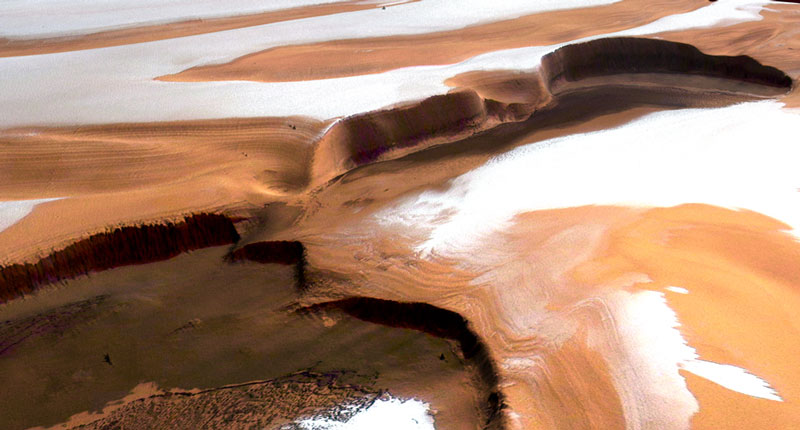Abruptes falaises sur Mars
On trouve des falaises verticales de près de 2 km de haut près du pôle nord de Mars. Des régions rouges de roche et de sable et des zones sombres de composition inconnue, mais qui seraient faites de cendres volcaniques sont également visibles sur cette image de la calotte polaire nord. Les falaises borderaient une caldeira volcanique. Bien que la chute abrupte des falaises martiennes soit extrême, le dénivelé n'est pas aussi profond que d'autres régions de notre système solaire, comme le canyon Colca de 3,4 km de profondeur sur Terre et Verona Rupes de 20 km de profondeur sur la lune d'Uranus Miranda. Cette image, retravaillée numériquement pour lui donner de la perspective, a été prise par la caméra stéréo à haute résolution embarquée à bord de la sonde automatique Mars Express de l'ESA, actuellement en orbite autour de Mars. Au passage, ne manquez pas Saturne et Vénus ce soir !
L'image d'astronomie du jour (Astronomy Picture Of the Day - APOD)
Traduction réalisée par Laurent Laveder
D'autres images d'astronomie...
Ailleurs sur le web
ESA
The European Space Agency portal features the latest news in space exploration, human spaceflight, launchers, telecommunications, navigation, monitoring and space science.

www.esa.int
Glacial, volcanic and fluvial activity on Mars: latest images
These images, taken by the High Resolution Stereo Camera (HRSC) on board ESA’s Mars Express spacecraft, were released at the First Mars Express Science Conference this week. They show the areas of focused research - water, ice, glaciers and volcanism.

www.esa.int
Glacial, volcanic and fluvial activity on Mars: latest images
These images, taken by the High Resolution Stereo Camera (HRSC) on board ESA’s Mars Express spacecraft, were released at the First Mars Express Science Conference this week. They show the areas of focused research - water, ice, glaciers and volcanism.

www.esa.int
Mars Express overview
ESA Science features news and resources to inspire the general public and inform the media on the latest discoveries in space exploration, in particular in the search for life on other planets and the origins of the universe.

www.esa.int
Au th??tre du ciel ce soir
Ce soir, dans le ciel, les d?cors ne seront pas de Roger Harth, ni les costumes de Donald Cardwell. Pourtant, il s?y jouera une pi?ce en deux actes des plus captivantes, mettant en sc?ne un spectaculaire lever de Lune, et une rencontre tr?s rapproch?e entre Saturne et V?nus.

www.cidehom.com
An Overview of the Solar System, it's alignment and pictures
The solar system consists of the Sun; the eight official planets, at least three "dwarf planets", more than 130 satellites of the planets, a large number of small bodies (the comets and asteroids), and the interplanetary medium.

www.nineplanets.org
Mars - Educational facts and history of the planet Mars.
Mars is the fourth planet from the Sun and the seventh largest.Mars (Greek: Ares) is the god of War. The planet probably got this name due to its red color; Mars is sometimes referred to as the Red Planet. (An interesting side note: the Roman god Mars was a god of agriculture before becoming associated with the Greek Ares; those in favor of colonizing and terraforming Mars may prefer this symbolis [...]

www.nineplanets.org
Maps / Products | USGS Astrogeology Science Center
USGS Astrogeology Science Center works with NASA and space-science communities to integrate planetary maps, geology, and remote sensing for Mars, Venus, the Moon, Mercury, Asteroids, Titan, Io, and more.

astrogeology.usgs.gov

